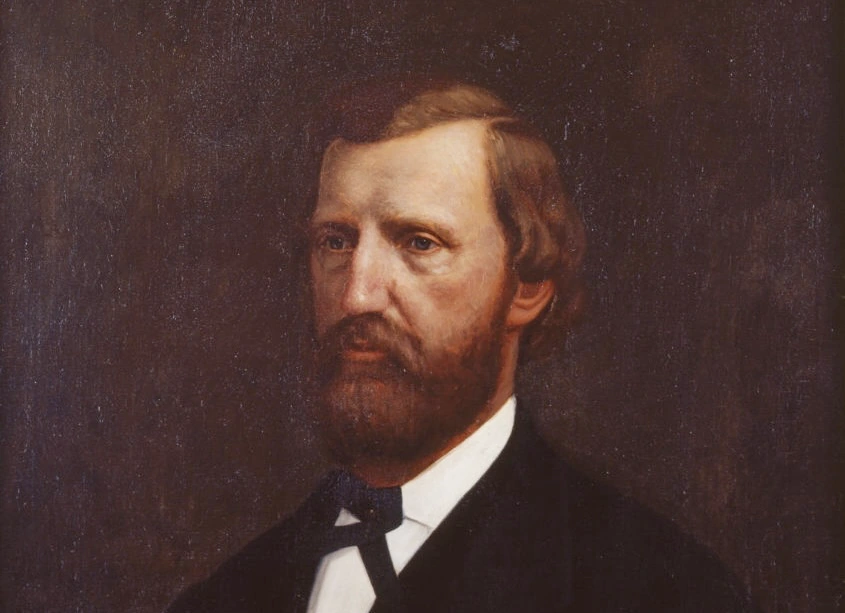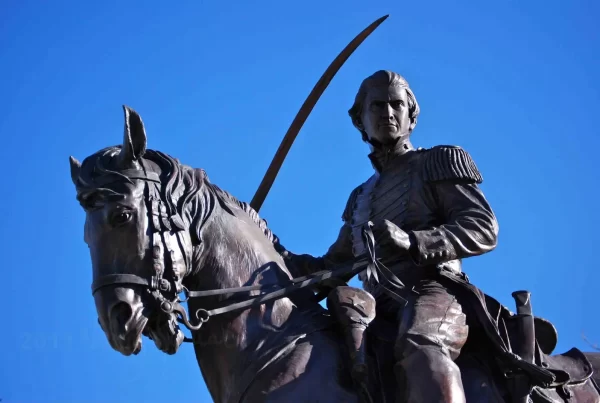Peter Hansborough Bell (1810–1898) served as the third Governor of the State of Texas and later represented Texas in the U.S. House of Representatives. The owner of 1,700 acres of land that he had received for his military service to the Republic of Texas, Bell brought to office a militant vision of Texas sovereignty and territorial expansion. Though he did not attain lasting fame, Bell was an important figure in Texas during an era of rapid westward settlement and frontier violence.
Military Background and Early Reputation
Bell was born on May 11, 1810, in Spotsylvania County, Virginia. He studied at the University of Virginia before moving westward in the early 1830s, drawn to the cause of Texian independence. He arrived in Texas in time to enlist in the Texian Army during the Texas Revolution, serving under Sam Houston and participating in the decisive Battle of San Jacinto in 1836.
After independence, Bell joined the fledgling Republic’s military efforts against Native tribes and Mexican incursions. His leadership in various skirmishes earned him distinction, and in 1840, he was appointed inspector general of the Republic of Texas Army. He later joined the Texas Rangers and developed a reputation as a fierce Indian fighter—a quality that would define his political persona.
During the Mexican-American War, Bell served as a colonel in the Second Regiment of Texas Mounted Volunteers under General Zachary Taylor. His actions at Monterrey and Buena Vista brought him further acclaim. This combination of military service, frontier experience, and patriotic credentials laid the foundation for his political rise.
Governorship: Border Defense and Expansion
Bell was elected governor of Texas in 1849 as a Democrat, succeeding George T. Wood. His administration came during a time of uncertainty over Texas’s boundaries, finances, and administrative integration into the Union. Among his first priorities was resolving territorial disputes in the vast western frontier of Texas—especially the claim to lands that extended into present-day New Mexico.
Governor Bell forcefully asserted Texas’s jurisdiction over the Santa Fe region, then under control of the U.S. military and newly acquired by treaty from Mexico. He dispatched a special commissioner to establish Texan governance and lobbied the legislature to authorize a force to seize control if necessary. This aggressive move placed him in direct conflict with federal authorities and contributed to the tensions that led to the Compromise of 1850.
Although Texas ultimately ceded its western claims in exchange for $10 million under the compromise, Bell’s actions reinforced his image as a staunch defender of state sovereignty and territorial rights. The funds from the federal settlement helped stabilize the state’s finances and fund future infrastructure projects.
Bell’s governorship also addressed lawlessness on the frontier and the continuing threat of Native raids. He advocated for expanded Ranger patrols and military installations to protect settlements in West and Central Texas. While critics accused him of relying too heavily on military solutions, Bell maintained broad support in rural areas for his firm stance on border security.
He was reelected in 1851 but resigned early in his second term in 1853 to accept a seat in the U.S. House of Representatives, where he served from 1853 to 1857. His successor, Lieutenant Governor James W. Henderson, briefly served the remainder of the term.
Congressional Career and Later Life
In Congress, Bell represented Texas’s western interests and supported Democratic Party positions aligned with states’ rights, territorial expansion, and pro-slavery policy. He backed the Kansas-Nebraska Act and remained committed to southern interests during a period of rising sectional tension. Nevertheless, he played a relatively minor role in national politics and chose not to seek reelection after two terms.
Bell largely withdrew from political life in the late 1850s and returned to his private affairs. During the Civil War, he supported the Confederacy, though he did not serve in any official capacity. Following the war, Bell resided for a time in North Carolina, his wife’s home state, before returning to Texas in his later years.
He died on March 8, 1898, in Littleton, North Carolina, at the age of 87. His remains were eventually reinterred in the State Cemetery in Austin, Texas, in recognition of his contributions to the state’s formative decades.
Advertisement
Legacy and Historical Assessment
Peter H. Bell occupies a relatively obscure place in Texas political history, but his influence during a pivotal transitional period was significant. As governor, he embodied the martial, expansionist spirit of Antebellum Texas.
His legacy is particularly tied to the state’s westward orientation. Bell County, established in 1850, was named in his honor—a testament to his perceived role in protecting and populating the Texas frontier. Yet Bell is also remembered by modern critics for the pro-slavery and anti-Native views that informed many of his policies.



